Rebecca Ashton talks to a truly inspiring trainer –
Hans Heinrich Meyer zu Strohen
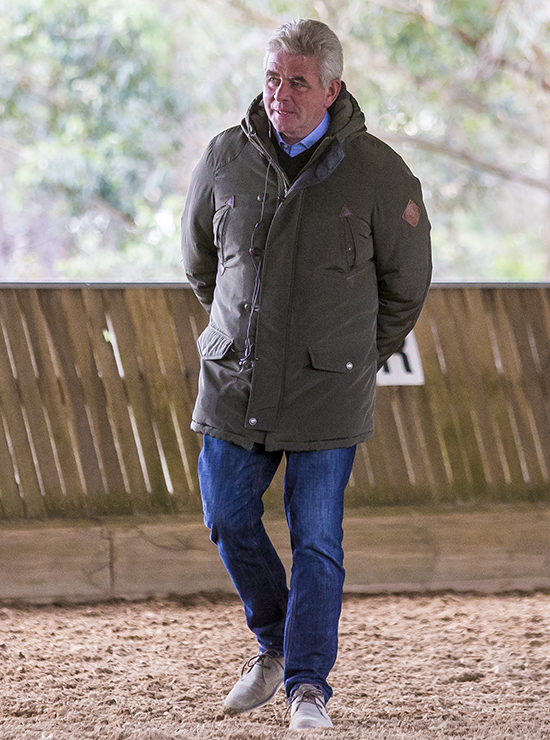
You’re known to be “The Trainer” for young riders and young horses, why did you choose that path?
I started my life working all the time with young horses, and later young riders and I’m very happy in this job. It’s a good feeling to give the young people the right way with dressage schooling and also with the training of the young horses. I also have some older horses that go Grand Prix. It’s very interesting to have the different levels and it’s a good feeling for myself.
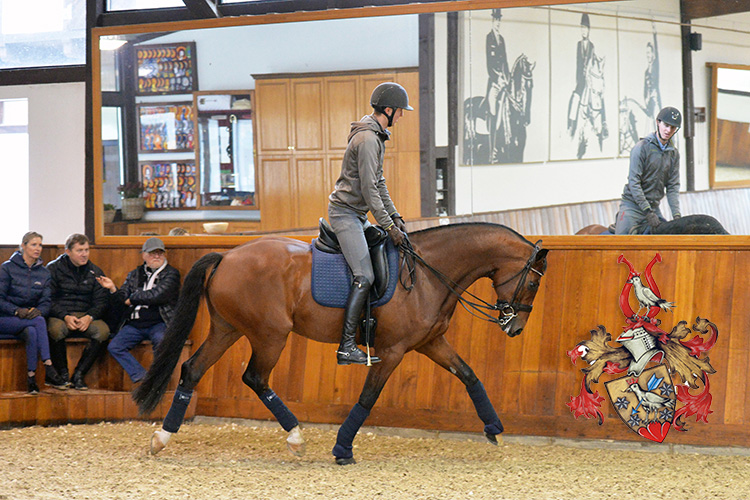
The Rothenberger family at home, Sönke rides and Gonnelien and Sven watch on – the young riders need ‘horse families’
You’ve trained young riders to a high level, competing at the top competitions and Germany has had some very young Olympians like Nicole Uphoff and Sönke Rothenberger. They’ve obviously had the right horse and right training, but mentally are they just very special or can you train that?
I think most of these people are coming out of horse families. Like Isabell Werth, Kristina Sprehe and Fabienne Lütkemeier. They are all horse families. They are working from the beginning together and most of them also have the parents’ help or a special trainer. It’s a good way to all train together and to take the time. It’s a very big problem to get the right horse and to have enough time. To school the horse and the rider, you need more than one year. You must have a very, very good combination in all areas.
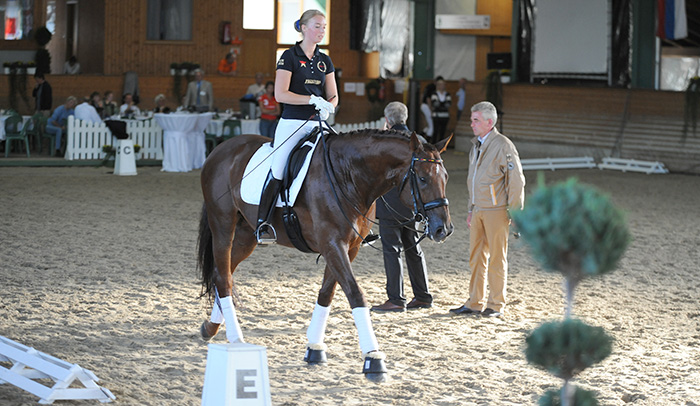
Fabienne Lütkemeir rides in the Seminar with Hans Heinrich and Martin Plewa at the DOKR in Warendorf
I guess it’s not even just about having the best horse and the best trainer, it’s about having that special relationship.
Yes, today you must have everything; you must have the person, the horse, the hall with good footing, the vets and also what we have more and more, people to train the riders in their own fitness. Everything is going up more and more. Twenty years ago the rider just sat on the horse and trained on the horse, now you have a special person for everything. You must have the special saddle, bit, bridle and also that the horse is working not for a longer time, but in a special way, maybe training in the morning and then in the afternoon he goes outside or is walking in hand. So some of the horses are going two times out of the box, sometimes even three or four times. All the good horses are part of the family. They are not machines that you just take out. There is a special management for each horse. It’s professional work and it’s very difficult. You must train and plan very well also. In the season if you have three or four shows, you say ok, I will go this year to the Europeans or the Olympics, you have to plan it step by step. You can’t take the horse out every month to a show. He must have a very strong plan coming up and up, and the show is the end.
This is very difficult and you must have good people around you and a good system that you feel that the horse is well in himself. What do you need to do more? What do you need to do less? Do you need to train the muscles or train more his concentration? All these different things.
For me as a trainer, it’s always the situation, it doesn’t matter if it is a young person or not, when you have special shows with lots of good riders, your rider thinks, “Oh no, I see this guy is also here and riding in my class! He’s much better than me!”
“No, he’s not better! It doesn’t matter. He wins, but he’s not better than you.” You must help this person so they know they’re not as bad as they think they are. Let them know that they can do it. Ten years ago it was not talked about, but now people are talking about it and some have also a special person who talks to them before the test for ten minutes, relaxes them. It helps them, helps the concentration. Some people need it, some don’t. It’s more open now, all these ideas. It’s very, very interesting.
We have in our sport so many new things. I ask sometimes, “Do we need it?” Sometimes I think there are too many things, that we need the natural things. But I think it’s better to have too many things and decide you don’t need it, but maybe you try it and then you know it’s good for you.
For the horses also, sometimes you just ride in the morning, or maybe late in the afternoon. If the horses have all the time the same routine and you go to a special show where you have to ride the horse late in the afternoon, the horse thinks, “No. Late in the afternoon I sleep!”That’s the same with the weather or the ground. The horse is living in a very sweet and nice house at home, and then it goes to another place then it can’t cope. It must know that it can also go on the hard ground or in the rain.
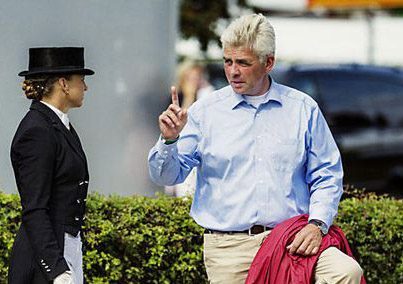
Talking to Dorothee Schneider
That’s part of training I guess, exposing the horse to different situations. Do you encourage your riders to take the horses out on rides?
Some horses need it, and some horses, it’s not good for them. They can be too nervous. You must find the right thing for your horse, listen to the horse. Also it helps to have a super groom who is all the time by the horse, in the stables, at the horse show, in the truck, the same person. The horse knows the person and when they are there they know everything is ok.
Grooms are very important people!
Ja! Absolutely. You must have a groom who is also living in this family. Then it all works together. If you say, “Oh that’s just the groom,”I think that’s stupid. The groom is one of the biggest people in the team.
With all this new technology, I guess it is trial and error, there’s always something new and people are trying to make money. How far do you take it?
No, it’s always just have the normal things and out of these normal things you feel, oh perhaps this or that is needed, then you can try it. The jumping riders are special. They can change very quick with the bit and other things. We as dressage riders are happy when we have one style and one way, we are happy and don’t change it quickly. That’s our way and it’s working. Some dressage riders, when they change too quickly, they don’t find the right way then you start going away from your riding system because you are all the time thinking about the bit or other things instead of focusing on the riding.
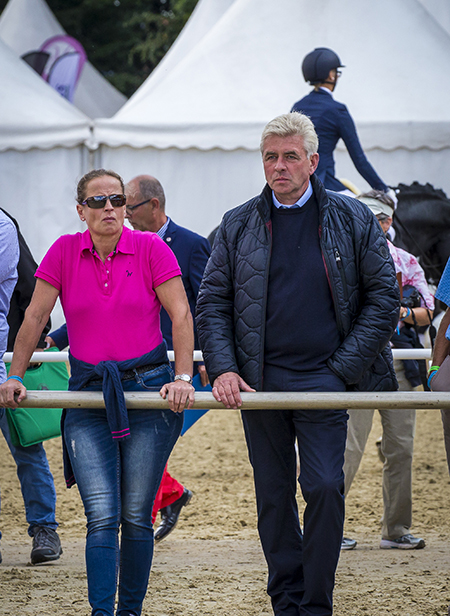
Watching at the Bundeschampionat with Isabell Werth
Talking about the young riders, are there any out there we should be keeping our eyes on for the future?
The best person for me right now is Sönke Rothenberger. He is absolutely top. The first time I saw the horse (Cosmo), it was just amazing what the horse can do. On the other side, he is such an interesting horse. They must play with him the whole day. He’s not a horse you can just leave in the box. He always needs something to do. So they take the horse out or he has something to play with so his head is working. In the night he will sleep, but during the day, he needs lots of things to do. It is very, very difficult to have such a horse with such impulsion from himself when you go to horse shows. You must have time so he knows all the new things. He can be very crazy in the arena because there is a new camera, new flowers or something. He must learn it and you must spend a lot of time with such a horse. All day.
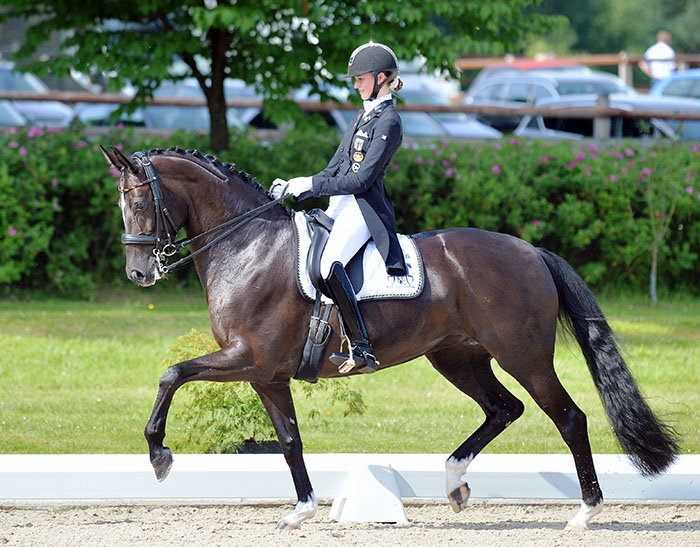
Semmieke Rothenberger – super tough Photo Kenneth Braddick Dressage-News
Sönke’s sister Semmieke, she is now riding Young Riders and she had two very, very super mares and last weekend she won two classes at Warendorf. I think she is a person who can win this year’s European Championships. She is really super and really tough and the horses are very, very good.
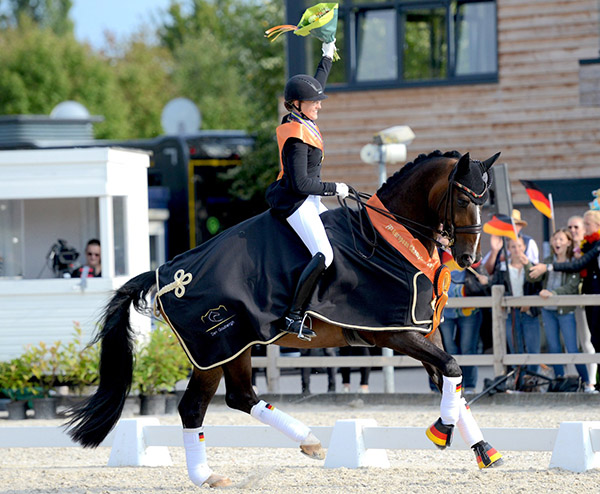
Hannah Erbe, another prospect for the German team…
Hannah Erbe was a Junior and Young Rider. She wins Europeans every year and also has a super horse. This year she is 18 and she can ride at the European Championships, but her horse is going Grand Prix so she is stepping forward to the Under 25 group. She is absolutely strong in herself. She is being trained by Heiner Schiergen. He is not far away from Isabell Werth so Hannah decided she would go half a day to Isabell in the stable, just help and have a look how she is training, how she is managing the horses. Just to see it and learn what she needed to do with her own horses. Now she is riding two of Isabell’s horses so this young person is hot, in the riding, in the training and they will be the winners. Other people are riding but they will not be the winners in the test. This girl, from the beginning, you could just have one or two words to her and she understands straight away and does it.
more follows…
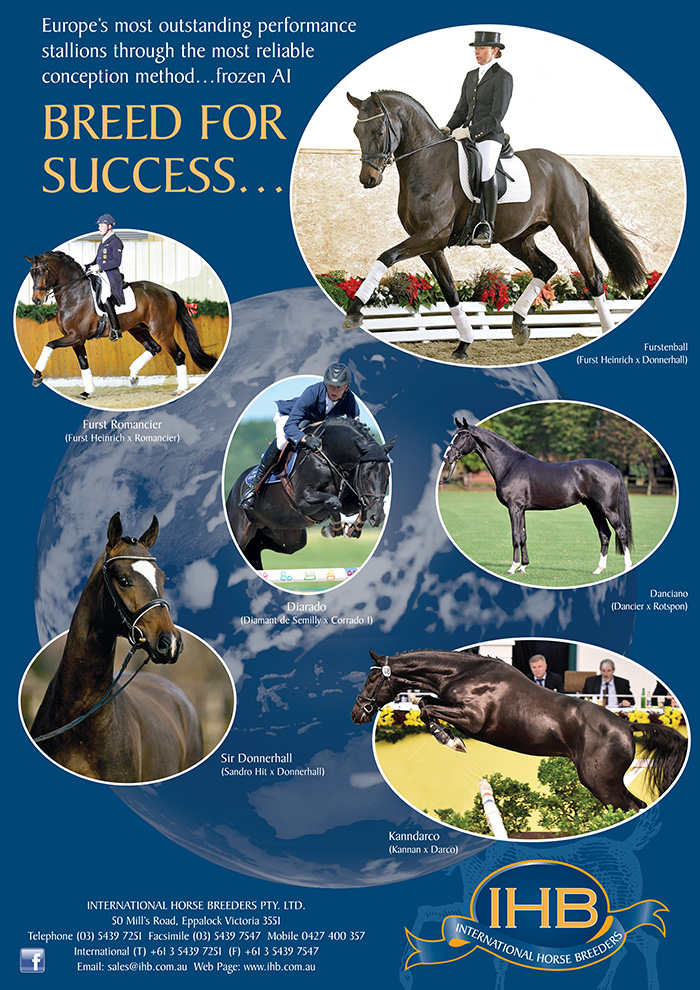 So many other people, they spend all the money for the horse and the truck and for the trainer and they train and train and they’re always third or fourth, but not the winner. In the competition, “Oh I forgot this or I did that wrong.”They are not strong enough in themselves to be the winner. That’s the difference.
So many other people, they spend all the money for the horse and the truck and for the trainer and they train and train and they’re always third or fourth, but not the winner. In the competition, “Oh I forgot this or I did that wrong.”They are not strong enough in themselves to be the winner. That’s the difference.
Some of them can train and train and ride and ride but they just can’t win at the top level. In Germany we have many good riders and we can be happy that we have this. Also, I can say ok this time for Juniors, I can send two and a half groups to the Europeans. We have so many. We didn’t have so many a year ago. They were not so good in training, or didn’t have the right horse. But now the combinations are better.
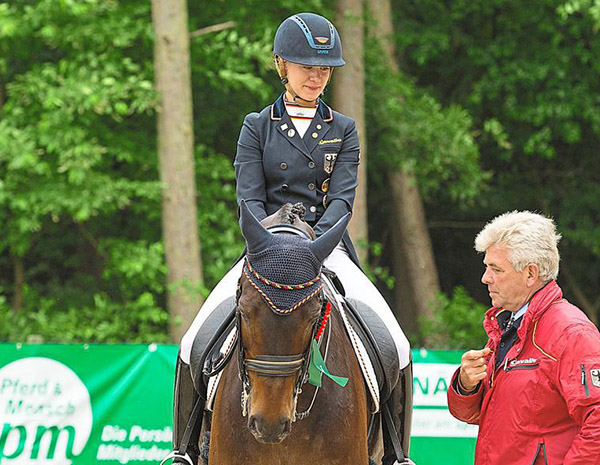
Claire-Louise Averkorn is congratulated by Hans Heinrich
When the parents know that it’s good for their child, then they do everything. It is not a problem with the dressage rider going to parties all night! They know if they go partying all night, they can’t ride in the morning. They can be happy and can go to the party for a while, but the sport is good for the child so the parents spend the money. And you need your parents; all the travelling to the shows and the training. Sometimes that is the best when the father and mother can do it together, so most of the families are always together.
It’s a lot of work, you can’t just grab a bag and go do your sport. With riding you need so many things, it’s not so easy. It’s great that these young people do this very, very strong work. They go to school and other friends are asking them, “What are you doing all day with the horse? That’s crazy. You can’t go to parties, you can’t sleep in.”Some children might swim and it takes only one hour and it’s finished. You must be very strong in yourself to do this work, and you must do this work every day, every week, every month. You can’t take a holiday from the work.
How do you keep children interested then without burning them out? I wonder where the balance is. I guess it depends on the personality too.
Ja but sometimes you get these young people, they have a super horse and maybe they get some problems with the horse or it gets old so they get another one and the second one is not so good or a little bit difficult. With the first horse they were the winner, with the next horse they can’t be the winner. Most of them give up. What I think, and what I would like to say, these people must learn that they cannot be the winner all the time. In yourself you can be. “I trained so much and I did a really, really good test and I’m so happy, but I’m third not the first.”and I say, “Super, super! Yes, but you are the winner in yourself. That’s your life and your horse.” Don’t say, the judges should give me better marks. No, no. It’s different. It’s your feeling that’s important, and your special win.If you just focus on the ribbons, you are not in the right way.
There are two girls in my young rider group, they ride so much, and so well, and I like it so much, but both of them have horses that can do, what they can do, but neither can get over 70%. They all the time get 68, 69. I sit there, and hope the judges will give them a little bit more, but they don’t. But they work so well. They do the test, and come out, and it was really good, but they say, oh the judges! I say no, wait, it was very good. Then they understand, and later in the day they are also happy.
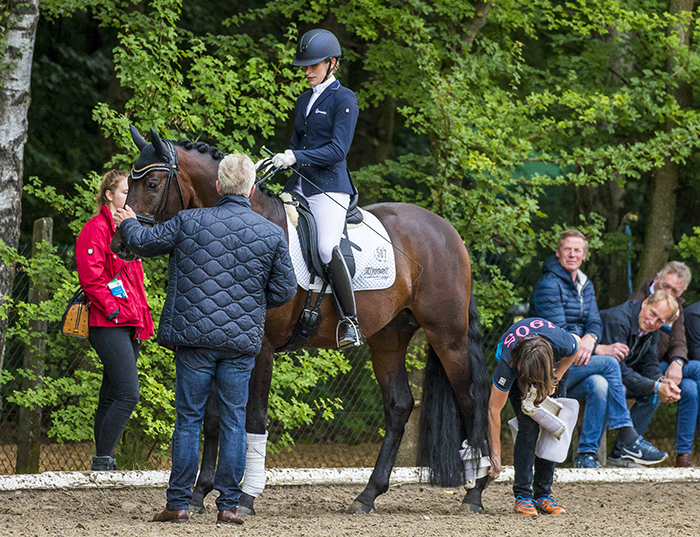
Last minute instructions for Beatrice at the Bundeschampionat from Hans Heinrich…
Obviously you warm a lot of people up for the big comps. I interviewed Beatrice Buchwald who you warmed up at the Bundeschampionat and she says you talk to her from the start so that when she goes into the competition arena, she can hear your voice in her head the whole way around. Do you consciously do that? What’s your warm up process?
Yes. So that the people know what I’m training and what I say and they can focus and work on that.
I also interviewed New Zealand rider Andrea Bank who is in this clinic and she said the one big thing she learnt while she was in Germany was to ride from your seat. Could you maybe expand on this, explain it a little?
You know, it’s always the same. You must find for yourself a really, really deep seat and the concentration on the seat, with your body, with your muscles, with your leg and with your hand. When you don’t have this feeling, you have the concentration all the time on your hand and you work and focus just on the hand, you are the loser. So as a trainer we always focus on the situation of the basic of the seat and we give the information to the rider. No that’s not right from your seat, or your hands are working too much backwards. We have to focus on this, and also that we have contact with the judges, so that we say‘come on, get the marks down on the person where these things aren’t so good so the people work also on themselves.’
What is good is to focus on the seat from the beginning and all the time. Riders that don’t have a good trainer, they lose these things, and they don’t have a good concentration.
What can people do to help the feeling, the connection? No stirrups?
The thing that I say, ok your Mum must make a video, just five minutes how you’re working with your horse and the rider sees that then they understand, and then they correct it from themselves much quicker. They can focus on that and fix it.
Also in the riding hall we have a television. You are riding, look at the television to see what you’ve done right now so they see it in the next second and they can correct themselves much quicker.
next we watch Hans Heinrich teach
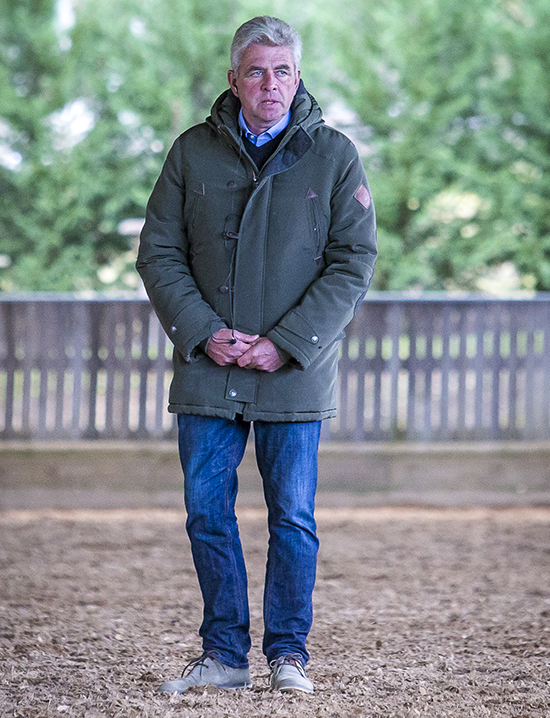
Watching Hans Heinrich Meyer zu Stohen teach is like listening to a great piece of music. The progress is subtle, gradually reaching a crescendo.
I really can’t think of a better analogy to describe how the horse evolves within a working session under his watchful eye. The mark of a master is how simple things are kept, and simple things are not always the easiest, but Hans Heinrich is a master. If you’re going to his clinic to be bombarded with way-out imagery, and to see how many movements you can put together in one sequence, you will be sorely disappointed. His main focus is being genuine about the rhythm and activity; reaction without speed. Despite these non-negotiables, the approach is individual to each combination.
Hannah Scott is riding her nine-year-old imported Callum Park Starbucks when I arrive for the working sessions. Circling to the right, Hans Heinrich wanted good bend right, but not forgetting that the outside leg had a role to play as well and had to remain on the horse’s body. “Calm, not faster. More balancing.”
Then into canter, “He needs to accept both legs. Quick. Reaction without the speed forward.”It was all about balance. In the transition to trot, Hans Heinrich wanted Hannah to wait for the transition while still encouraging Bucky forward with both legs but giving the hand.
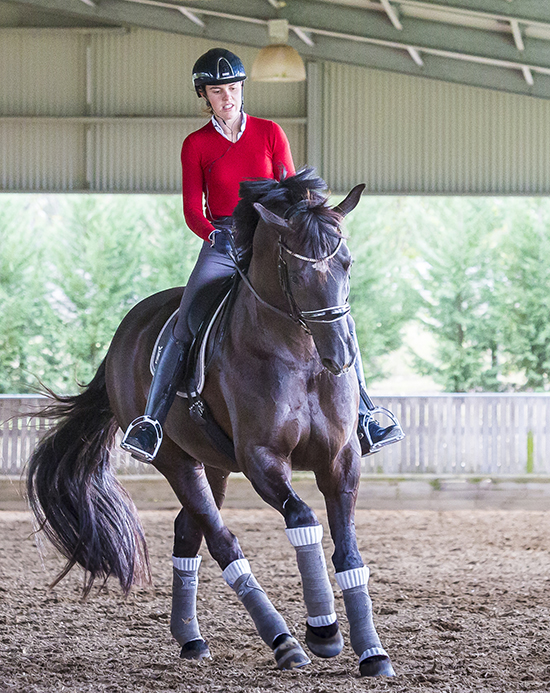
He’s riding each stride with Hannah. “Left leg on the body, left leg on the body,”rapid fire instructions. He’s supportive the whole time. Hannah’s horse wanted to back off when she was balancing him in the canter. “Two legs on and again.”Bucky had to really react without speed. “This amount of activity you can control. Both hands forward. Zo ist gut!”
Then to the right: “Yes you want the bend to the right but don’t lose the left side. And the canter, you make it with the leg, give the rein. Bring him back. Both legs active.”
Next the 20m circles got smaller. “Don’t lose it. Sit. He will do it. Try it again. Come on, come on. Shorter. He can do it! You’re waiting, and then into a little bit of a pirouette.”Hans Heinrich is positive and encouraging.
Even the walk on a loose rein as a break had to be the best quality.
Next a walk/canter transition, but it had to be repeated, “The second one was quick, the first one was lazy and waiting.”Then it was into a little pirouette work, Hannah had to keep Bucky reactive and listening to the leg, but balanced on the quarters. “Very good. You can do it. And walk. Pat him. Good boy.”
Hannah and Bucky were getting their reactions quicker, “Now more forward but not longer the rein. Make him quick on the leg. Quick forward. Super. That was a reaction. That wasn’t waiting.”The horse had to jump forward and not wait, “Forward but not crazy.”
Coming into the walk, it was still important to keep the horse quick as he was collecting. He still had to react to the leg. “Keep control of the outside rein. Don’t give it up. Even going into the walk, kick him.”Hans Heinrich was getting the horse reactive and reconnected. “For sure he’s not nervous. He’s just lazy.”
Hans Heinrich touched on half pass work. “Hold the body of the horse with the inside leg. Go on the left rein circle. School the inside leg. Stay on the circle. Now half pass left. Keep your left leg on his side so he doesn’t fall left.”
The lesson ended with a stretch at the trot, with attention to the neck being longer rather than deeper.
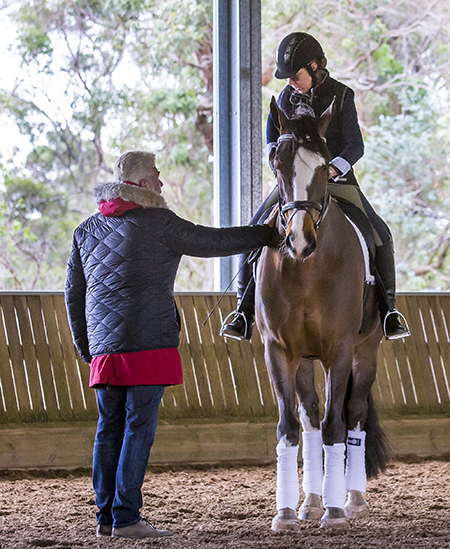
Bonnie Holstein was next with the lovely Clydie cross, The Illusionist. The ten-year-old is competing small tour, but has only been with Bonnie for three weeks.
The lesson began with a stretching walk on curved lines. “Pat him. You are happy, the horse is happy. Good.”True to the Training Scale, the first priority was relaxation. Then into trot, slow and relaxed on a long rein. No pressure and lots of pats. Even in this frame, the legs were helping the horse balance, with the inside leg creating the bend. The horse was finding his balance without any pressure or any help form the rein.
Then it was time to ask for a little more activity, but the rein remained long. “A little more active on the circle. Forward in the rhythm”.
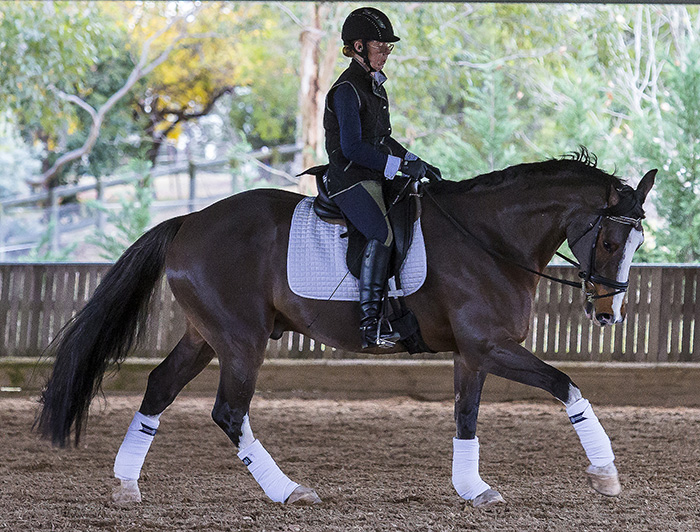
The work slowly built, alternating rising trot and sitting trot before a transition into canter. The rein was still long, but activity was required. “More spring in the canter so that he goes forward.”Bonnie also had to think shoulder in down the long side. The horse was feeling good and started to throw in some changes, which brought a chuckle from both rider and trainer. “It doesn’t matter,just keep rebalancing and keeping his body straight and maintaining a good rhythm.”
“Now bring the reins a little bit shorter. Not deeper, shorter rein and higher neck.Keep the outside rein. Very good. Then onto the circle to help put the horse together. The outside rein is there and just holds. You need to move your outside leg forward a little. You must feel which is better, more forward with it, or more back.”
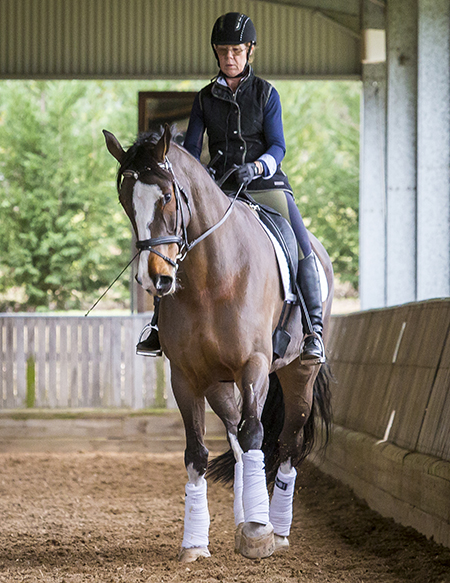
Next exercise was riding on the inside track, working on trot and canter transitions, alternating left and right strike offs, keeping the horse very straight, controlling the horse’s body and training counter canter on the short side. With the horse being more eager, things had to be slowed down, he had to wait more.
In the middle of the session it was a return to a little bit of stretchy trot before a walk break. “He’s a hard worker. You can sit and feel.”
Back to trot work and shoulder in. “Not too fast. A little bit more bend. Control the body position. He’s lost a little of the swing. Just a little bit more forward, but keep the rhythm. That’s much better. Not higher the hand, make the hand deeper. On the circle, school the inside leg, then into shoulder in. Good forward, good swinging. Have a little smaller bend in the neck and feel the shoulder come in.”
With the shoulder in going well they progressed to half pass. “Get forward first and keep the forward in the half pass. Not more sideways. Then you have really good swinging forward over the body.”
When the final stretching trot was asked for, Bonnie threw the reins to reward the horse. “Not so quick down. Do it again. You want the reins longer, yes, but you also want the nose forward. Longer. That’s better.”
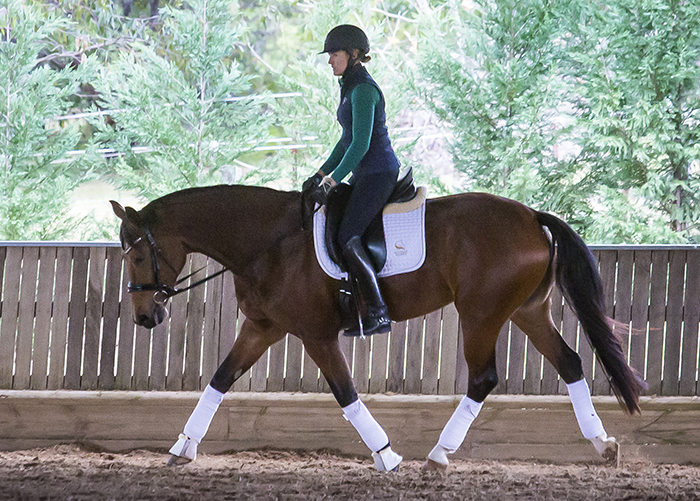
Melanie Campbell is no stranger to Hans Heinrich or his method. Having been stationed at the Hanoverian Verband in Germany for three years, Melanie trained with Hans Heinrich basically the whole time. Her first lesson in this clinic was on Florette, an eight-year-old Florestan/Breitling mare who Melanie has been riding for five months. With the lesson held in German and my German being less than brilliant, I had to get Melanie to check my notes!
The work began in a stretchy walk with some leg yield, really suppling up the horse before a relaxed trot, no rein contact, but still looking for shoulder control and maintaining an active but not fast tempo. Then in the canter; long, stretching, very little contact but the horse was well on the seat and leg, it was almost playful. If the horse’s head went up a couple of times, no big deal, just rebalance and resume. Melanie is such a balanced rider, she never gets in the way.
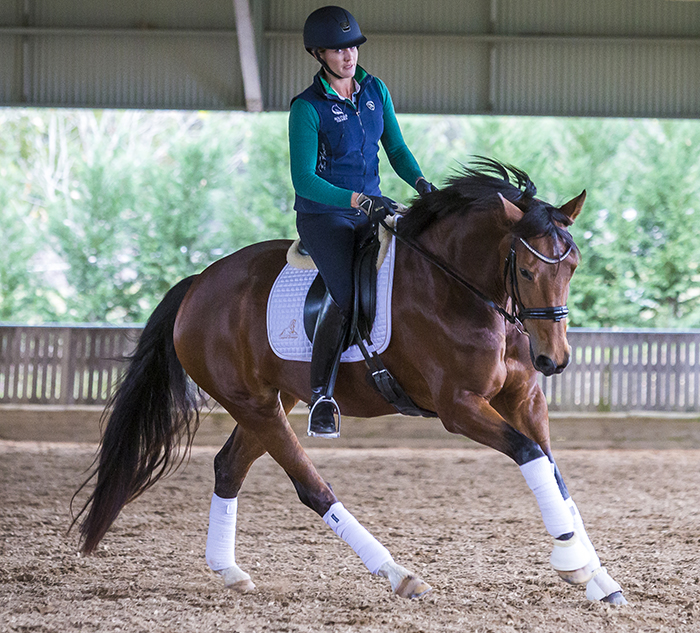
All this was done on big, 20 metre circles, focusing on tempo control but keeping the quickness behind and balancing the horse. This continued as the horse was put into a higher head carriage. Still the rein was long and the contact light as a feather.
The more that was asked of the young mare, the more she started to grunt and hold back, so Melanie had to encourage her to stay in front of the leg, really keeping her active and forward. It was the same at the canter, both legs getting a forward reaction from the horse without her running away. Kick, kick, kick until there was a reaction. There may have been the odd little buck, but it got smoother as Florette decided it was easier just to react forward through her body and give rather than tighten and run forward.
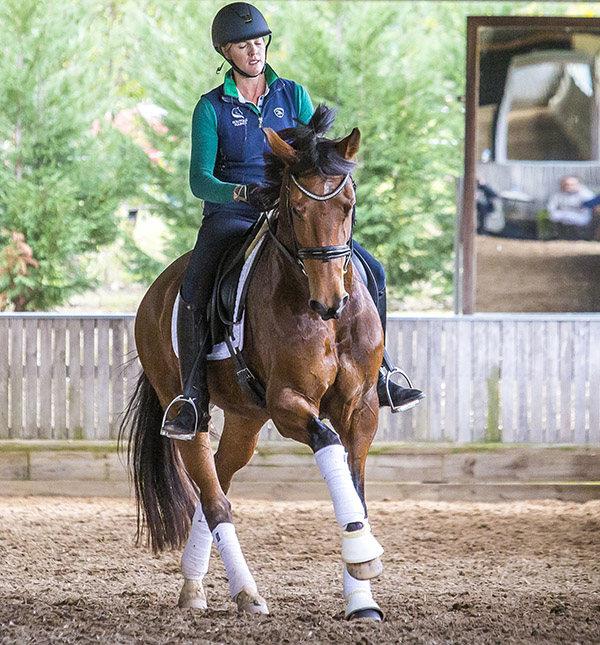
Into the leg yield at the trot and again, not faster, just reactive and through, before cantering on the track. The mare had to react with more jump. The next exercise to encourage that was travers on a 20 metre circle then straight and forward on the circle line. Forward and back in the canter on the circle, Florette had to remain super active even as she came back. Then the circle became a little smaller with the quarters in. When the horse backed off, kick, kick, re-establish the reaction to the leg. It was all very black and white and consistent. Flying change and the other way. Then a bit of lengthening before a stretching canter, but Florette wasn’t allowed to back off for a second.
Of course, the session finished with the stretchy trot, loose and big, rather than fast.
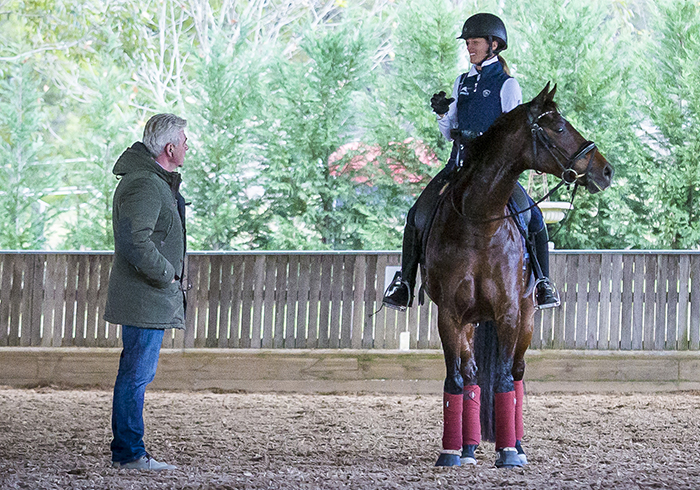
Andrea Bank is no stranger to the German system having recently returned from a three-year stint with Jonny Hilberath.
Andrea’s adorable little six-year-old mare Dakira had strong ideas today helped in no way by her being in season, so the work was about setting some boundaries.
She was required to walk correctly from the start, “Circle right, don’t give up the left side. You have to have the left side really connected then you can get the bend to the right. Use your inside leg for the bend without giving up the outside rein. The outside leg also holds. You must get the middle of the horse to give, that’s why I also say hold with the outside leg.”Now the horse was starting to supple her body but occasionally Andrea had to ask for a proper reaction from her inside leg. Then onto a straight line with Andrea giving the reins longer, the mare having to step out longer rather than rush.
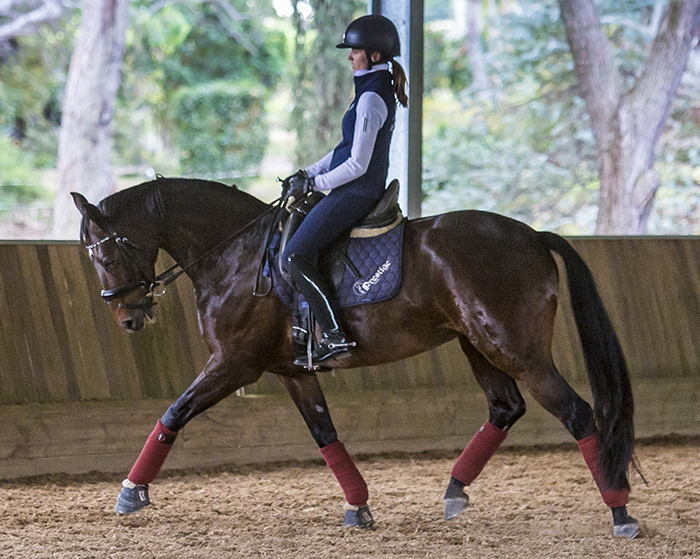
Then into the trot.”Not fast, not fast, not too much forward.”The softer the horse got, the bigger the stride became. Big 20 metre circles at the trot, still with the position and control of the horse’s body taking priority; longer rein, inside leg active, keeping the outside under control. When the horse got too fast, the extra tension stifled the swing a little. That didn’t mean the horse didn’t need to be reactive though.
Then they played with walk, trot transitions before more circles. The mare just realised there were other horses around outside. She had a little talk to them but the correction from the rider was soft and consistent. Andrea just stuck to her guns and waited.
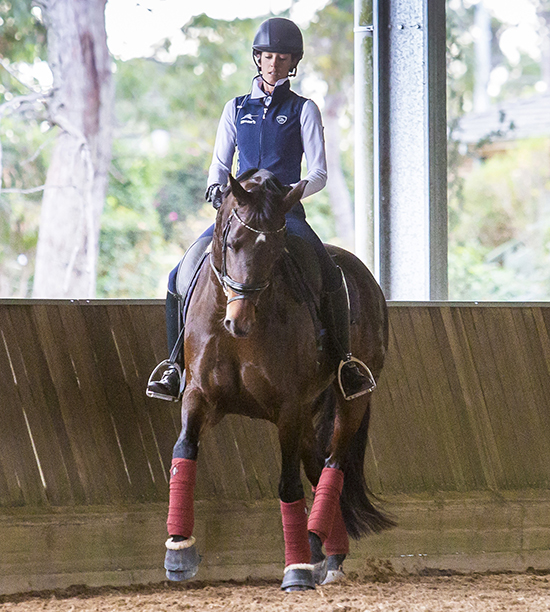
Shoulder in at the trot with the shoulders coming in off the outside aids. Like Bonnie’s horse, it was shoulder in into voltes, keeping the horse’s attention.
On to the canter with the inside leg creating activity, but not speed on 20 metre circles with forward and back transitions. Still Andrea had to make sure she didn’t give up the outside rein, sometimes it helped to counter flex Dakira.
We all know how important transitions are, and you see a lot of them in a Hans Heinrich lesson. In the trot canter transitions, Andrea needed to keep the contact a little and hold more with her body. When the mare got too free, she lost her activity which turned into speed. The mare was not always impressed with the request to work harder, but there was never any punishment, just Andrea being stubborn in the best possible way until the mare came to the party.
After a walk break, the same work continued using leg yield in the walk on a 20 metre circle, getting the horse to respond to the inside leg and catching and controlling with the outside aids. Then the same exercise at the trot. That feeling was then taken into shoulder in down the long side with a volte half way along, making sure the bend was good and true.
Then the work got more concentrated; trot and volte in the corner, then into shoulder in for a few strides before across the diagonal and volte in the first corner. Over and over getting the mare to concentrate by using exercises, “You have the neck, don’t give it up.”The work was short and intense and Andrea really had to ride. She was the boss and had to keep control, but it didn’t go on forever. Then there was the stretchy trot to finish up.
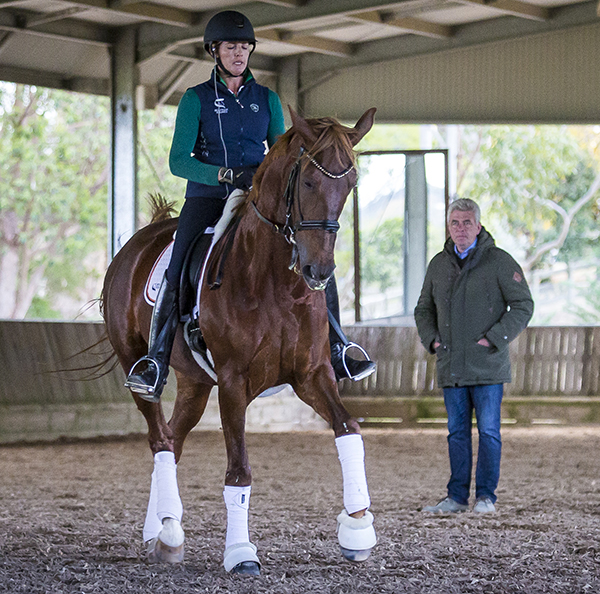
Melanie was back in the arena with the big imported Breitling mare Boronia. What a sweet soul this horse is, and Melanie has been riding her for 12 months, working towards Grand Prix.
Leg yield at walk was first before trot, big and loose on long, flowing lines followed by the canter. Then trot/ canter transitions, still with a lengthened frame.
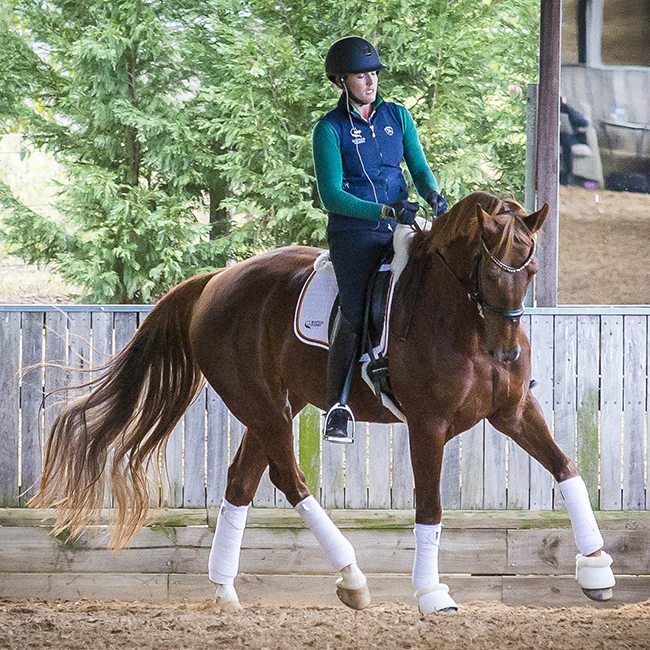
This progressed to putting Boronia together with shoulder in and voltes before some half pass. The horse had to respond to the leg by lifting the back and legs more. Sometimes she reacted in the wrong way, but the aid just continued, until the correct reaction was given. As the horse understood more and more, the work got more expressive and smoother.
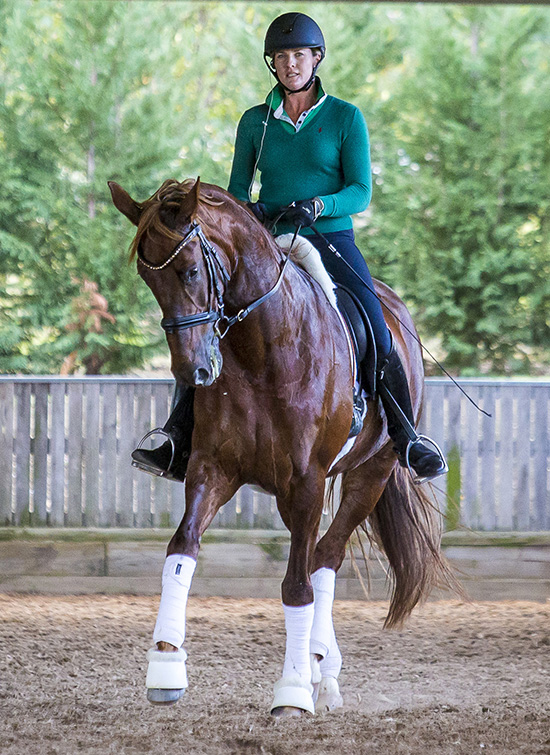
After a break it was back to the canter with voltes and shoulder in down the long side. Melanie was really starting to get the mare jumping. Flying change and then to the left rein. Inside leg to keep the jump, sometimes both legs to create more expression without throwing away the contact. The horse has a bigger, slower stride so the goal was to get her a little quicker off the ground.
Now the work was getting really collected. The horse was really trying so Hans Heinrich decided to play with some piaffe. Boronia was now in a totally different balance. Melanie was bringing her right back to a couple of steps piaffe, then forward and reactive while keeping the trot balanced, together and active.
Stretchy trot to end.
Melanie’s reaction?
I know Hans Heinrich’s system very well. The biggest difference from beginning to end is the way he has a real system, he builds you up to a point where you then can start to ask more of the horse. From my normal training until the end today, the expression of the movement improved, the amount of movement you start to be able to create and making them more electric. Even from yesterday to today, both horses were so much sharper from the leg, even though Boronia was a bit tired!
I think what’s incredible is his eye, to see things so quickly, to have you change it so quickly, but in a subtle, quiet way and he gives you, and it’s what I really love about his training and what I really miss, he gives you the confidence to do it. He doesn’t ever bring you down and say, “Why are you doing that? It’s crap.”He says good and you think ok, I can do it and I can keep doing it. I love that.
And the different exercises he gave me, like the exercise for the canter pirouette I thought was brilliant. He first started me at the walk, and he did this with me in Germany on my horse, you walk a straight line and then just turn the forehand a quarter, then straight and again and again on a square, and the quarters are the pivot, and he built that up into the canter and they were probably the best canter pirouettes I’ve had on her. We went up the quarter line, collect, collect and just turn the forehand. It’s so simple.
He has a really good ability to get you to ride the horses straighter through their bodies. Both the horses felt a lot straighter by the end. Keeping the outside rein, keeping the outside aids just gently there, and using the inside leg to just keep them coming through and through. He rides it with you, literally step by step.
Before I went to Germany, I didn’t really understand letting them really stretch to warm up and I think it really is still so missing here, just letting them stretch. We’ve got to understand they’re such a huge animal and they’ve got much bigger muscles than us, and they’ve got to be able to stretch and lift the back up and bring the hind leg through. When I first went to Germany, Hans Heinrich literally, for two weeks on my own horse said, “You’ve got to just let the reins go long. You are going to ride this horse for the next two weeks with long reins.”The concept almost killed me because you always want to keep it together. Then I realised, “Oh I don’t need my hands to keep everything together.”So the ability to warm up and stretch and not let the tempo get too fast because you want them to be able to swing over the back and use the hind leg, bring the hind leg through, this is just so important.
He slowly just built it up, make them quick and catch them and then building it from there to more swing. It’s all about getting more swing and more activity through the horse’s body. It’s the way he builds them up to that. I mean every single horse is different, but it’s all a similar way. He consistently just works away at the basics and it’s that that improves the “tricks”.
Andrea Banks talks about her lesson…
I loved it! I haven’t really trained with anyone since Jonny in Germany. I had one lesson on each horse when he was here in November! So I’ve been feeling a bit stuck. I loved it because Hans Heinrich got them more connected. I mean I had to be a bit stronger, but sometimes you have to be to get the point through, but today was completely different for both of them. They started off so much more through and connected and so I didn’t have to be so strong except sometimes in the moment when Dakira was being a bit naughty! She’s a real mare, but I love her. She’s cool, hey?! She’s got a bit of sass!
I think the differences… Jonny was very classical and perhaps I almost got a bit too soft. I perhaps got a little bit obsessed with the fact that they have to carry themselves and I feel like I’ve stopped riding and I think I’ve been a bit lost because she is quite a strong mare and I’m like, do I ride her up and get her more through her back that way, and not focus so much on her front end, but Hans Heinrich’s got me riding her a bit deeper and getting her more reactive from behind and that’s really helped. I walk into the arena and it just instantly takes you back to Germany again. I miss it!! I wish I could have a lesson with him again next week!
But I’m stoked because he’s given me a plan and that’s what I needed. I have a plan for the next three months or so and hopefully he’ll come back! I like his style because he gets a point through, but he’s not too hard. He builds your confidence, he’s always praising you and the horse and that kind of makes you think, ”Ok!”so you don’t get scared to try something new. This is what I need to get them more going, being a bit more assertive, I guess.
Dakira’s such a monkey and I also think because yesterday was the first time I’d trained with Hans Heinrich I was connecting everything. What we worked on yesterday really helped today.


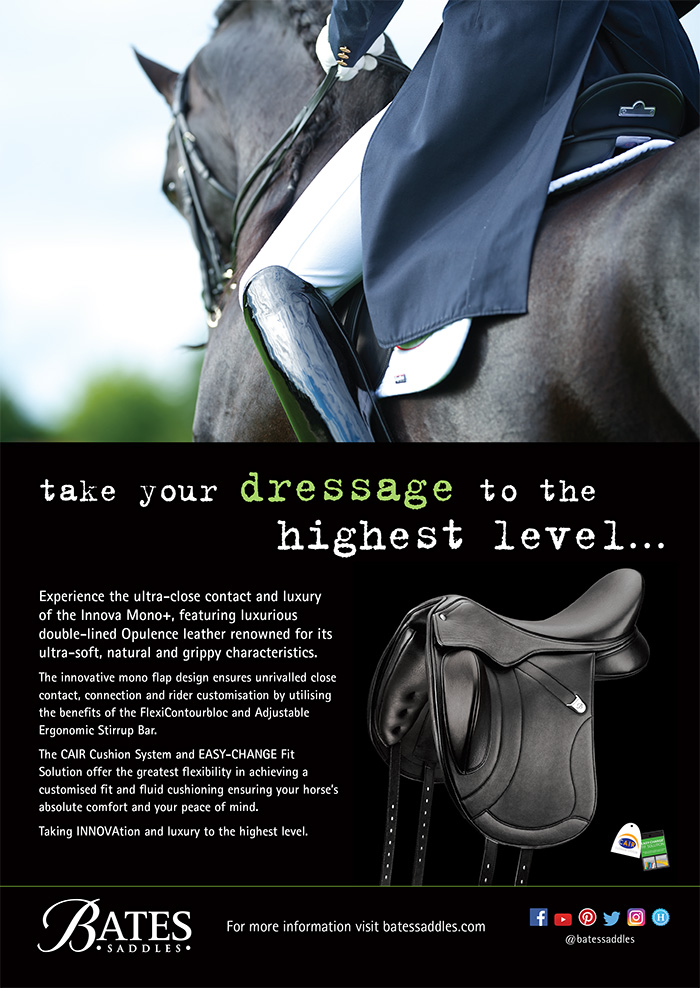
I was lucky to sit in on some of these lessons. The man is spectacular, a true gentleman, a horseman. Genius. I hope he comes back again and not too far in the future!